Instantaneous Square Current Signal Analysis for Motors Using Vision Transformer for the Fault Diagnosis of Rolling Bearings
Abstract
:1. Introduction
- For the reason that it is not suitable for practical industrial applications due to the restricted installation and high cost of vibration sensors, the MCS is selected as the analysis subject. And proposed a processing method, ISCV, for fault feature extraction in MCS;
- To solve the problem that traditional fault diagnosis methods cannot meet the requirements of diagnostic accuracy due to the low SNR of MCS, a diagnostic model based on ISCV-ViT is proposed for bearing diagnosis, which is evaluated on two datasets of rolling bearings to prove the model’s accuracy and practicality, namely, the public bearing dataset from Paderborn University (PU) and the laboratory bearing dataset of Shenzhen Technology University (SZTU).
2. Theoretical Basis
2.1. Transformer Model
2.2. Transformer Encoder
3. The Proposed Method
3.1. Description of the Proposed Method
3.2. Specific Details of the Fault Diagnosis Method (ISCV-ViT)
3.2.1. The Instantaneous Square Current Value
3.2.2. Input Embeddings
3.2.3. Transformer Blocks
3.2.4. Training Strategy
4. Experimental Validation
4.1. Case 1: Public Bearing Dataset of Paderborn University (PU)
4.1.1. Dataset and Experimental Apparatus
4.1.2. Experimental Setup of Case 1
4.1.3. Evaluation and Analysis of Case 1
4.2. Case 2: Laboratory Bearing Dataset of Shenzhen Technology University (SZTU)
4.2.1. Experimental Apparatus
4.2.2. Experimental Setup of Case 2
4.2.3. Results Analysis of Case 2
5. Conclusions
Author Contributions
Funding
Institutional Review Board Statement
Informed Consent Statement
Data Availability Statement
Conflicts of Interest
References
- Sheikh, M.A.; Bakhsh, S.T.; Irfan, M.; Nor, N.B.; Nowakowski, G. A review to diagnose faults related to three-phase industrial induction motors. J. Fail. Anal. Prev. 2022, 22, 1546–1557. [Google Scholar] [CrossRef]
- Peng, B.; Bi, Y.; Xue, B.; Zhang, M.J.; Wan, S.T. A survey on fault diagnosis of rolling bearings. Algorithms 2022, 15, 347. [Google Scholar] [CrossRef]
- Avina-Corral, V.; Rangel-Magdaleno, J.; Morales-Perez, C.; Hernandez, J. Bearing fault detection in adjustable speed drive-powered induction machine by using motor current signature analysis and goodness-of-fit tests. IEEE Trans. Ind. Inform. 2021, 17, 8265–8274. [Google Scholar] [CrossRef]
- Becker, V.; Schwamm, T.; Urschel, S.; Antonino-Daviu, J.A. Two current-based methods for the detection of bearing and impeller faults in variable speed pumps. Energies 2021, 14, 4514. [Google Scholar] [CrossRef]
- Lv, R. Research on Asynchronous Motor Rotor Fault Diagnosis Technology Based on Stator Current Characteristic Analysis; Xi’an University of Science and Technology: Xi’an, China, 2021. [Google Scholar]
- Chen, W. Research on Fault Diagnosis Method of Asynchronous Motor Based on Deep Transfer Learning; China University of Mining and Technology: Xuzhou, China, 2022. [Google Scholar]
- Long, Z.; Zhang, X.F.; Zhang, L.; Qin, G.J.; Huang, S.D.; Song, D.Y.; Shao, H.D.; Wu, G.P. Motor fault diagnosis using attention mechanism and improved adaboost driven by multi-sensor information. Measurement 2021, 170, 108718. [Google Scholar] [CrossRef]
- Zhu, X. Faults Detection of Locomotive Traction System by Modified Wavelet Bispectrum Motor Current Signature Analysis; Harbin University of Science and Technology: Harbin, China, 2020. [Google Scholar]
- Kim, S.J.; Kim, K.; Hwang, T.; Park, J.; Jeong, H.; Kim, T.; Youn, B.D. Motor-current-based electromagnetic interference de-noising method for rolling element bearing diagnosis using acoustic emission sensors. Measurement 2022, 193, 110912. [Google Scholar] [CrossRef]
- Ali, M.Z.; Shabbir, M.; Zaman, S.M.K.; Liang, X.D. Single- and multi-fault diagnosis using machine learning for variable frequency drive-fed induction motors. IEEE Trans. Ind. Appl. 2020, 56, 2324–2337. [Google Scholar] [CrossRef]
- Neupane, D.; Seok, J. Bearing fault detection and diagnosis using case western reserve university dataset with deep learning approaches: A review. IEEE Access 2020, 8, 93155–93178. [Google Scholar] [CrossRef]
- Shah, D.S.; Patel, V.N. A review of dynamic modeling and fault identifications methods for rolling element bearing. In Proceedings of the 2nd International Conference on Innovations in Automation and Mechatronics Engineering (ICIAME), Vallabh Vidyanagar, India, 7–8 March 2014; pp. 447–456. [Google Scholar]
- Godoy, W.F.; Morinigo-Sotelo, D.; Duque-Perez, O.; da Silva, I.N.; Goedtel, A.; Palacios, R.H.C. Estimation of bearing fault severity in line-connected and inverter-fed three-phase induction motors. Energies 2020, 13, 3481. [Google Scholar] [CrossRef]
- Song, L. Research on Fault Diagnosis of Planet Bearings Based on Analysis of Vibration and Motor Current; East China Jiaotong University: Nanchang, China, 2021. [Google Scholar]
- Wang, X.B.; Luo, L.Q.; Tang, L.L.; Yang, Z.X. Automatic representation and detection of fault bearings in in-wheel motors under variable load conditions. Adv. Eng. Inform. 2021, 49, 101321. [Google Scholar] [CrossRef]
- Li, H.Y.; Feng, G.J.; Zhen, D.; Gu, F.S.; Ball, A.D. A normalized frequency-domain energy operator for broken rotor bar fault diagnosis. IEEE Trans. Instrum. Meas. 2021, 70, 3500110. [Google Scholar] [CrossRef]
- Wang, W.D.; Song, X.J.; Liu, G.H.; Chen, Q.; Zhao, W.X.; Zhu, H.Y. Induction motor broken rotor bar fault diagnosis based on third-order energy operator demodulated current signal. IEEE Trans. Energy Convers. 2022, 37, 1052–1059. [Google Scholar] [CrossRef]
- Kabul, A.; Unsal, A. Diagnosis of multiple faults of an induction motor based on Hilbert envelope analysis. Metrol. Meas. Syst. 2022, 29, 191–205. [Google Scholar] [CrossRef]
- Naha, A.; Samanta, A.K.; Routray, A.; Deb, A.K. A method for detecting half-broken rotor bar in lightly loaded induction motors using current. IEEE Trans. Instrum. Meas. 2016, 65, 1614–1625. [Google Scholar] [CrossRef]
- Samanta, A.K.; Naha, A.; Routray, A.; Deb, A.K. Fast and accurate spectral estimation for online detection of partial broken bar in induction motors. Mech. Syst. Signal Process. 2018, 98, 63–77. [Google Scholar] [CrossRef]
- Singh, G.; Naikan, V.N.A. Detection of half broken rotor bar fault in VFD driven induction motor drive using motor square current MUSIC analysis. Mech. Syst. Signal Process. 2018, 110, 333–348. [Google Scholar] [CrossRef]
- Ma, H. Research on Fault Diagnosis of High Voltage Disconnector Mechanism Based on Motor Stator Current Characteristics; University of Science and Technology Beijing: Beijing, China, 2021. [Google Scholar]
- Bloedt, M.; Granjon, P.; Raison, B.; Rostaing, G. Models for bearing damage detection in induction motors using stator current monitoring. IEEE Trans. Ind. Electron. 2008, 55, 1813–1822. [Google Scholar] [CrossRef]
- Becker, V.; Schwamm, T.; Urschel, S.; Antonino-Daviu, J. Fault detection of circulation pumps on the basis of motor current evaluation. IEEE Trans. Ind. Appl. 2021, 57, 4617–4624. [Google Scholar] [CrossRef]
- Singh, S.; Kumar, N. Detection of bearing faults in mechanical systems using stator current monitoring. IEEE Trans. Ind. Inform. 2017, 13, 1341–1349. [Google Scholar] [CrossRef]
- Avina-Corral, V.; Rangel-Magdaleno, J.D.; Peregrina-Barreto, H.; Ramirez-Cortes, J.M. Bearing fault detection in ASD-powered induction machine using MODWT and image edge detection. IEEE Access 2022, 10, 24181–24193. [Google Scholar] [CrossRef]
- Jimenez-Guarneros, M.; Morales-Perez, C.; Rangel-Magdaleno, J.D. Diagnostic of combined mechanical and electrical faults in ASD-powered induction motor using MODWT and a lightweight 1-D CNN. IEEE Trans. Ind. Inform. 2022, 18, 4688–4697. [Google Scholar] [CrossRef]
- Zhang, X.T.; Hu, Y.H.; Deng, J.M.; Xu, H.; Wen, H.Q. Feature engineering and artificial intelligence-supported approaches used for electric powertrain fault diagnosis: A review. IEEE Access 2022, 10, 29069–29088. [Google Scholar] [CrossRef]
- Liang, X.B.; Yao, J.Y.; Zhang, W.F.; Wang, Y.R. A novel fault diagnosis of a rolling bearing method based on variational mode decomposition and an artificial neural network. Appl. Sci. 2023, 13, 3413. [Google Scholar] [CrossRef]
- Shifat, T.A.; Yasmin, R.; Hur, J.W. A data driven RUL estimation framework of electric motor using deep electrical feature learning from current harmonics and apparent power. Energies 2021, 14, 3156. [Google Scholar] [CrossRef]
- Kerboua, A.; Kelaiaia, R. Fault diagnosis in an asynchronous motor using three-dimensional convolutional neural network. Arab. J. Sci. Eng. 2023, 19. [Google Scholar] [CrossRef]
- Zhang, K.L.; Li, H.K.; Cao, S.X.; Yang, C.; Sun, F.B.; Wang, Z.B. Motor current signal analysis using hypergraph neural networks for fault diagnosis of electromechanical system. Measurement 2022, 201, 111697. [Google Scholar] [CrossRef]
- Park, C.H.; Kim, H.; Lee, J.; Ahn, G.; Youn, M.; Youn, B.D. A feature inherited hierarchical convolutional neural network (FI-HCNN) for motor fault severity estimation using stator current signals. Int. J. Precis. Eng. Manuf.-Green Technol. 2021, 8, 1253–1266. [Google Scholar] [CrossRef]
- Zhao, M.H.; Fu, X.Y.; Zhang, Y.J.; Meng, L.H.; Tang, B.P. Highly imbalanced fault diagnosis of mechanical systems based on wavelet packet distortion and convolutional neural networks. Adv. Eng. Inform. 2022, 51, 101535. [Google Scholar] [CrossRef]
- Li, D.C.; Zhang, M.; Kang, T.B.; Li, B.; Xiang, H.B.; Wang, K.S.; Pei, Z.L.; Tang, X.Y.; Wang, P. Fault diagnosis of rotating machinery based on dual convolutional-capsule network (DC-CN). Measurement 2022, 187, 110258. [Google Scholar] [CrossRef]
- Zhao, X.L.; Yao, J.Y.; Deng, W.X.; Ding, P.; Zhuang, J.C.; Liu, Z. Multiscale deep graph convolutional networks for intelligent fault diagnosis of rotor-bearing system under fluctuating working conditions. IEEE Trans. Ind. Inform. 2023, 19, 166–176. [Google Scholar] [CrossRef]
- Zhao, X.L.; Yao, J.Y.; Deng, W.X.; Ding, P.; Ding, Y.F.; Jia, M.P.; Liu, Z. Intelligent fault diagnosis of gearbox under variable working conditions with adaptive intraclass and interclass convolutional neural network. IEEE Trans. Neural Netw. Learn. Syst. 2022. Early Access. [Google Scholar] [CrossRef] [PubMed]
- Zhao, X.L.; Yao, J.Y.; Deng, W.X.; Jia, M.P.; Liu, Z. Normalized conditional variational auto-encoder with adaptive focal loss for imbalanced fault diagnosis of bearing-rotor system. Mech. Syst. Signal Process. 2022, 170, 108826. [Google Scholar] [CrossRef]
- Vaswani, A.; Shazeer, N.; Parmar, N.; Uszkoreit, J.; Jones, L.; Gomez, A.N.; Kaiser, L.; Polosukhin, I. Attention is all you need. In Proceedings of the 31st Annual Conference on Neural Information Processing Systems (NIPS), Long Beach, CA, USA, 4–9 December 2017. [Google Scholar]
- Dosovitskiy, A.; Beyer, L.; Kolesnikov, A.; Weissenborn, D.; Zhai, X.; Unterthiner, T.; Dehghani, M.; Minderer, M.; Heigold, G.; Gelly, S. An image is worth 16 × 16 words: Transformers for image recognition at scale. In Proceedings of the International Conference on Learning Representations, Virtual Event, 3–7 May 2021. [Google Scholar]
- Ding, Y.F.; Jia, M.P.; Miao, Q.H.; Cao, Y.D. A novel time-frequency Transformer based on self-attention mechanism and its application in fault diagnosis of rolling bearings. Mech. Syst. Signal Process. 2022, 168, 108616. [Google Scholar] [CrossRef]
- Tang, X.Y.; Xu, Z.B.; Wang, Z.G. A novel fault diagnosis method of rolling bearing based on integrated vision Transformer model. Sensors 2022, 22, 3878. [Google Scholar] [CrossRef]
- He, Q.C.; Li, S.B.; Bai, Q.; Zhang, A.S.; Yang, J.; Shen, M.M. A siamese vision Transformer for bearings fault diagnosis. Micromachines 2022, 13, 1656. [Google Scholar] [CrossRef]
- Wu, G.G.; Yan, T.Y.; Yang, G.L.; Chai, H.Q.; Cao, C.C. A review on rolling bearing fault signal detection methods based on different sensors. Sensors 2022, 22, 8330. [Google Scholar] [CrossRef]
- He, K.M.; Zhang, X.Y.; Ren, S.Q.; Sun, J. Deep residual learning for image recognition. In Proceedings of the 2016 IEEE Conference on Computer Vision and Pattern Recognition (CVPR), Seattle, WA, USA, 27–30 June 2016; pp. 770–778. [Google Scholar]
- Saucedo-Dorantes, J.J.; Zamudio-Ramirez, I.; Cureno-Osornio, J.; Osornio-Rios, R.A.; Antonino-Daviu, J.A. Condition monitoring method for the detection of fault graduality in outer race bearing based on vibration-current fusion, statistical features and neural network. Appl. Sci. 2021, 11, 8033. [Google Scholar] [CrossRef]
- Devlin, J.; Chang, M.W.; Lee, K.; Toutanova, K. BERT: Pre-training of Deep Bidirectional Transformers for Language Understanding. In Proceedings of the 2019 Conference of the North American Chapter of the Association for Computational Linguistics: Human Language Technologies (Naacl Hlt 2019), Minneapolis, MN, USA, 2–7 June 2019; Volume 1, pp. 4171–4186. [Google Scholar]
- Kingma, D.; Ba, J. Adam: A method for stochastic optimization. arXiv 2014, arXiv:1412.6980. [Google Scholar]
- Ruder, S. An overview of gradient descent optimization algorithms. arXiv 2016, arXiv:1609.04747. [Google Scholar]
- Lessmeier, C.; Kimotho, J.K.; Zimmer, D.; Sextro, W. Condition monitoring of bearing damage in electromechanical drive systems by using motor current signals of electric motors: A benchmark data set for data-driven classification. In Proceedings of the European Conference of the Prognostics and Health Management Society, Chengdu, China, 19–21 October 2016. [Google Scholar]
- Kabir, H.; Garg, N. Machine learning enabled orthogonal camera goniometry for accurate and robust contact angle measurements. Sci. Rep. 2023, 13, 1497. [Google Scholar] [CrossRef]
- Bolon-Canedo, V.; Remeseiro, B. Feature selection in image analysis: A survey. Artif. Intell. Rev. 2020, 53, 2905–2931. [Google Scholar] [CrossRef]
- Sun, M.D.; Wang, H.; Liu, P.; Long, Z.; Yang, J.T.; Huang, S.D. A novel data-driven mechanical fault diagnosis method for induction motors using stator current signals. IEEE Trans. Transp. Electrif. 2023, 9, 347–358. [Google Scholar] [CrossRef]
- Toma, R.N.; Prosvirin, A.E.; Kim, J.M. Bearing fault diagnosis of induction motors using a genetic algorithm and machine learning classifiers. Sensors 2020, 20, 1884. [Google Scholar] [CrossRef]
- Hoang, D.T.; Kang, H.J. A motor current signal-based bearing fault diagnosis using deep learning and information fusion. IEEE Trans. Instrum. Meas. 2020, 69, 3325–3333. [Google Scholar] [CrossRef]
- Piedad, E.; Chen, Y.T.; Chang, H.C.; Kuo, C.C. Frequency occurrence plot-based convolutional neural network for motor fault diagnosis. Electronics 2020, 9, 1711. [Google Scholar] [CrossRef]

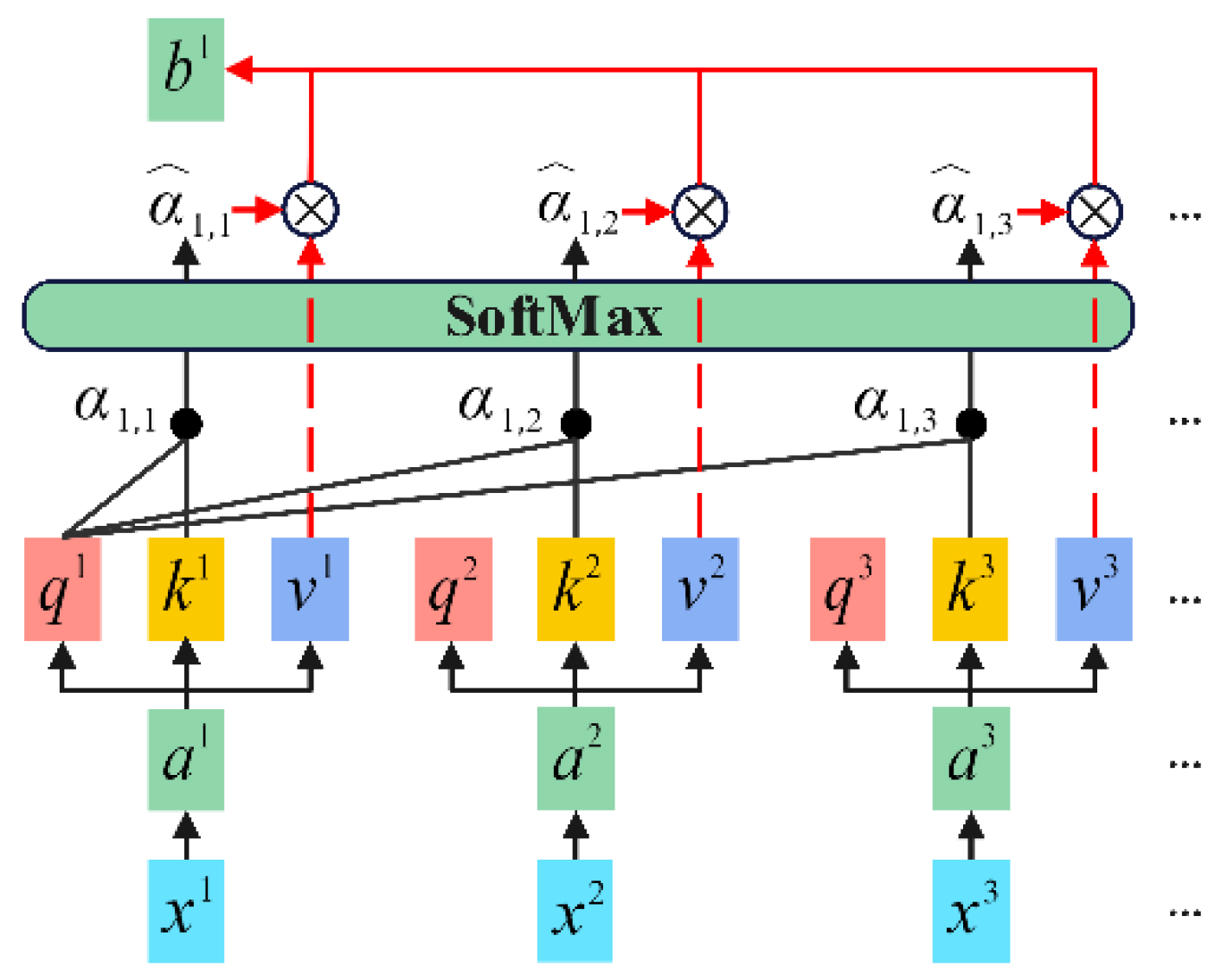
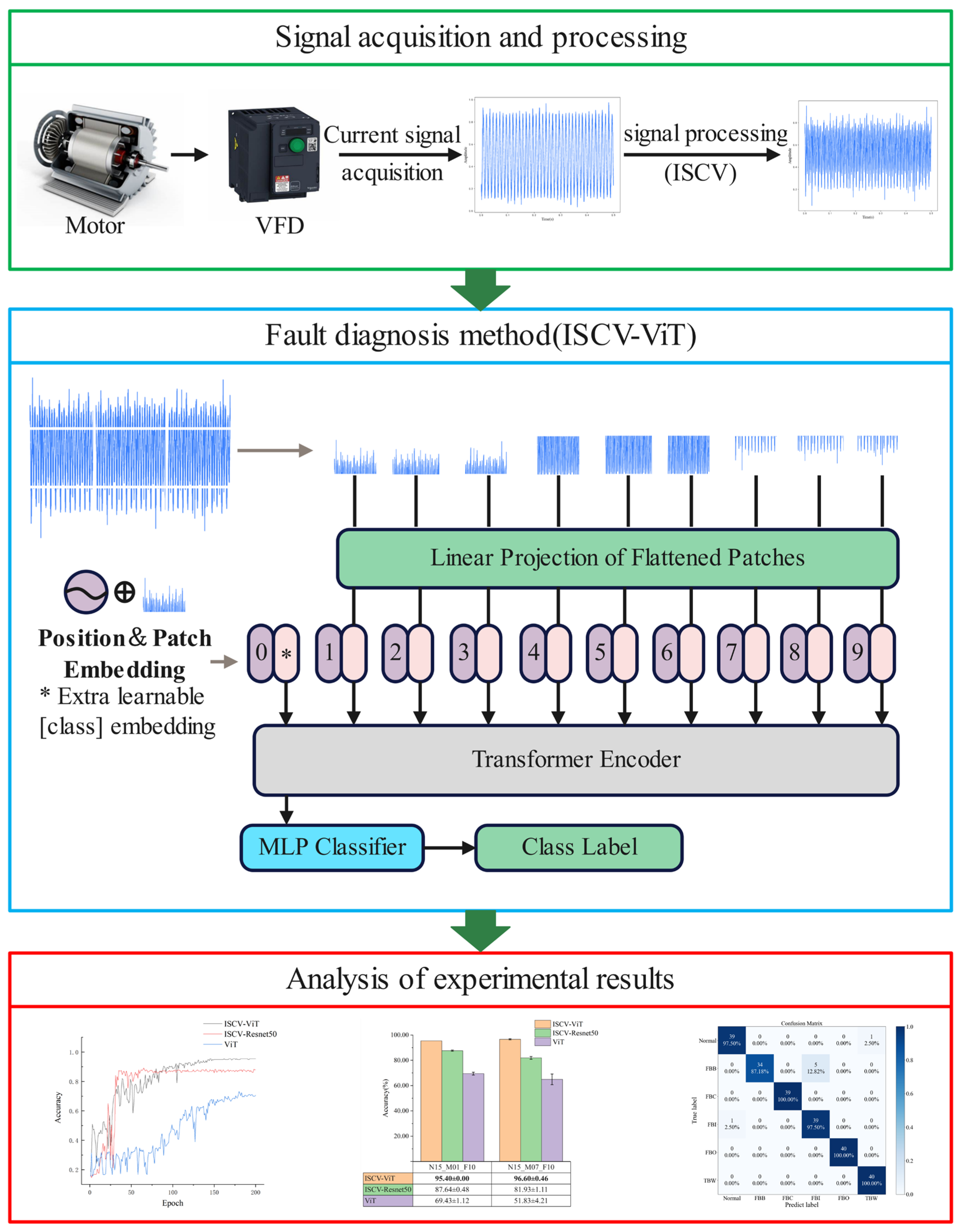
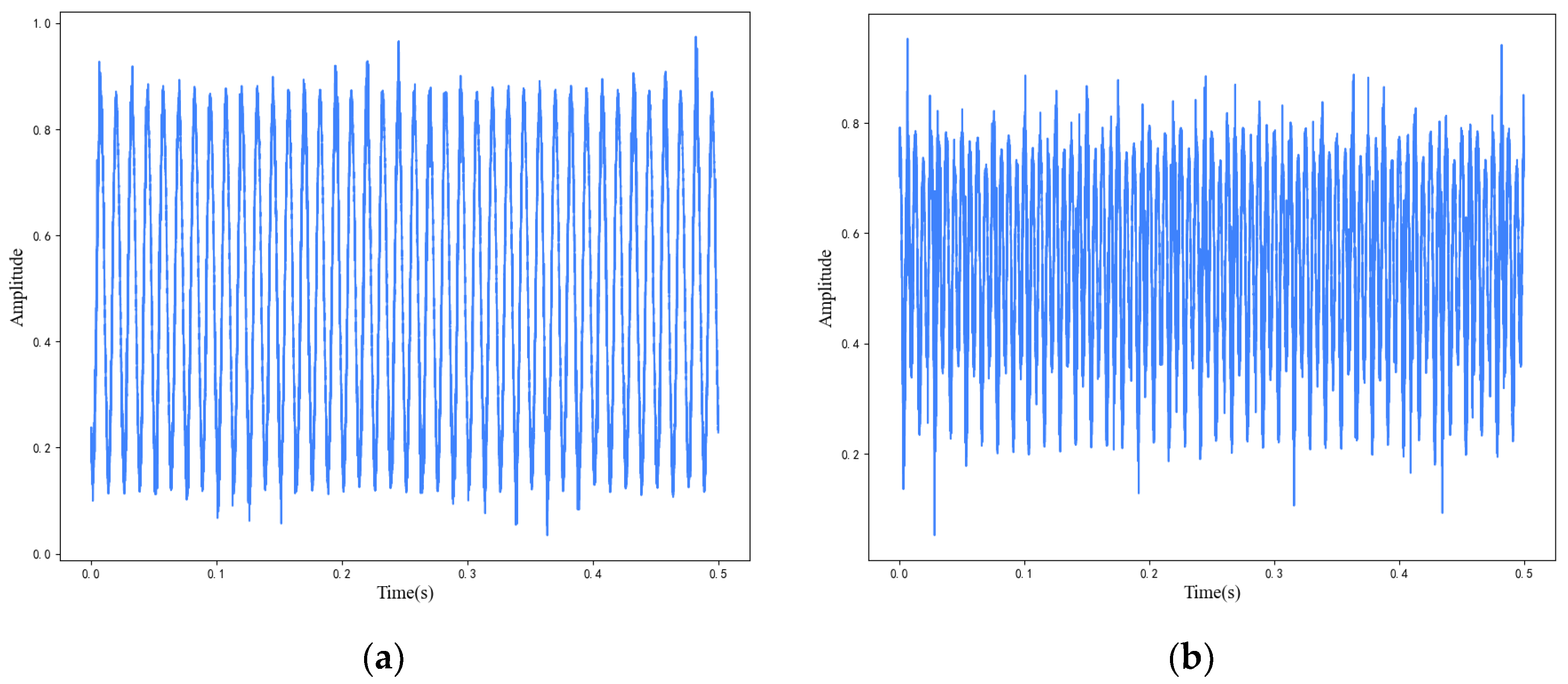
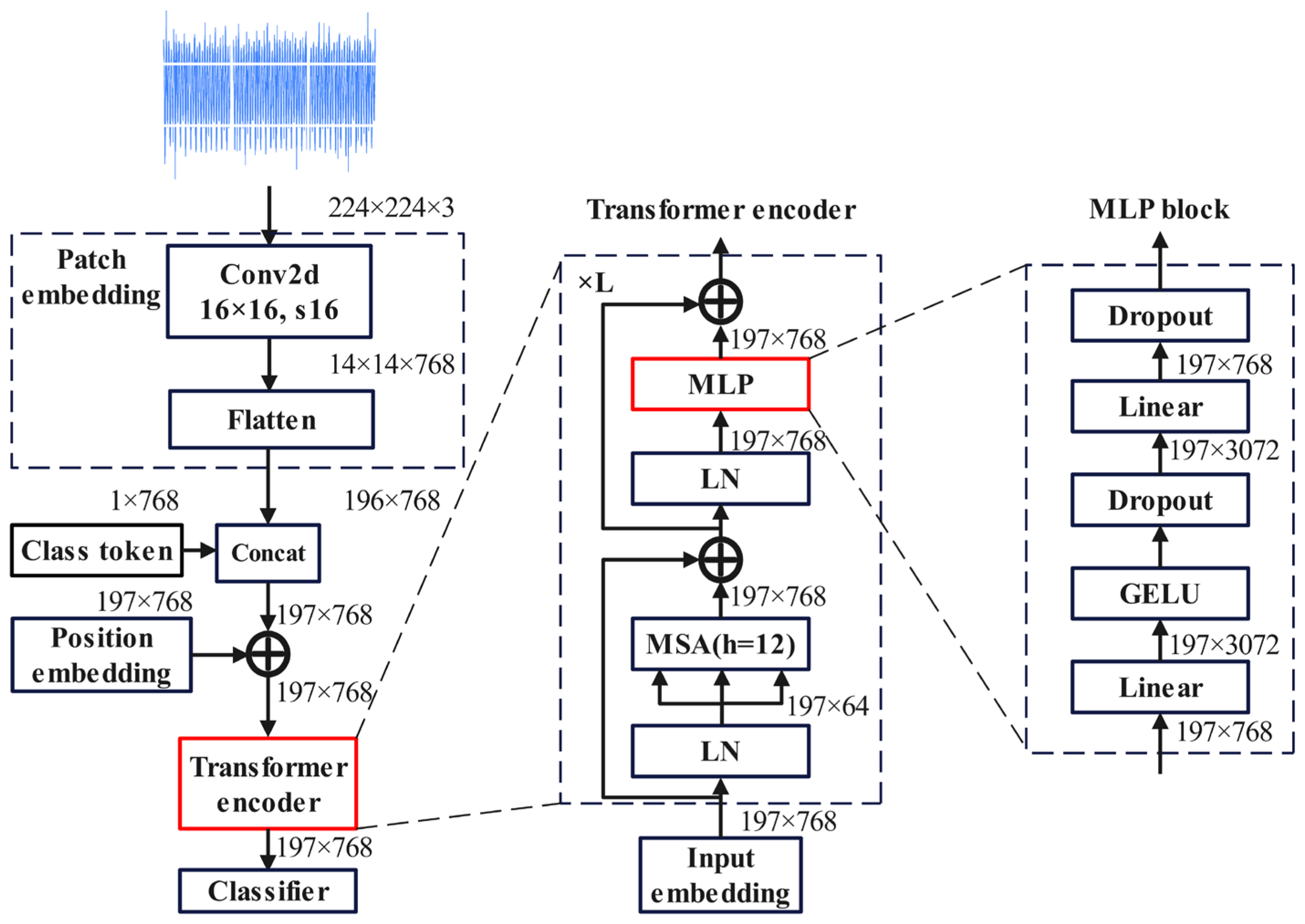
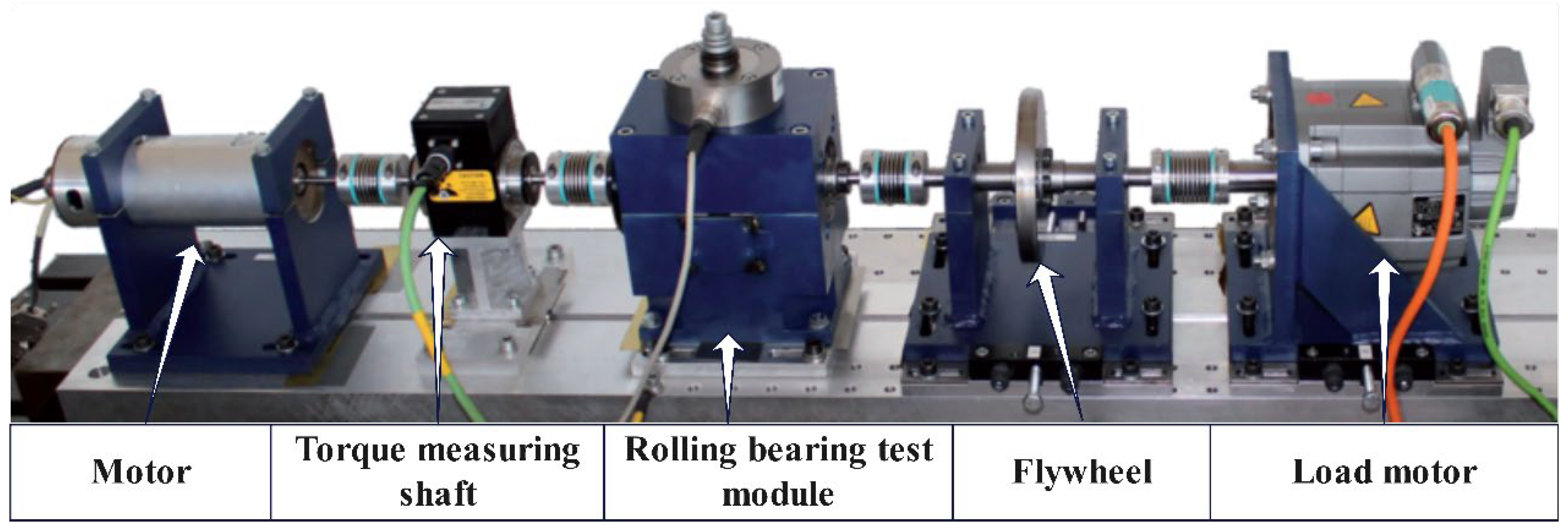

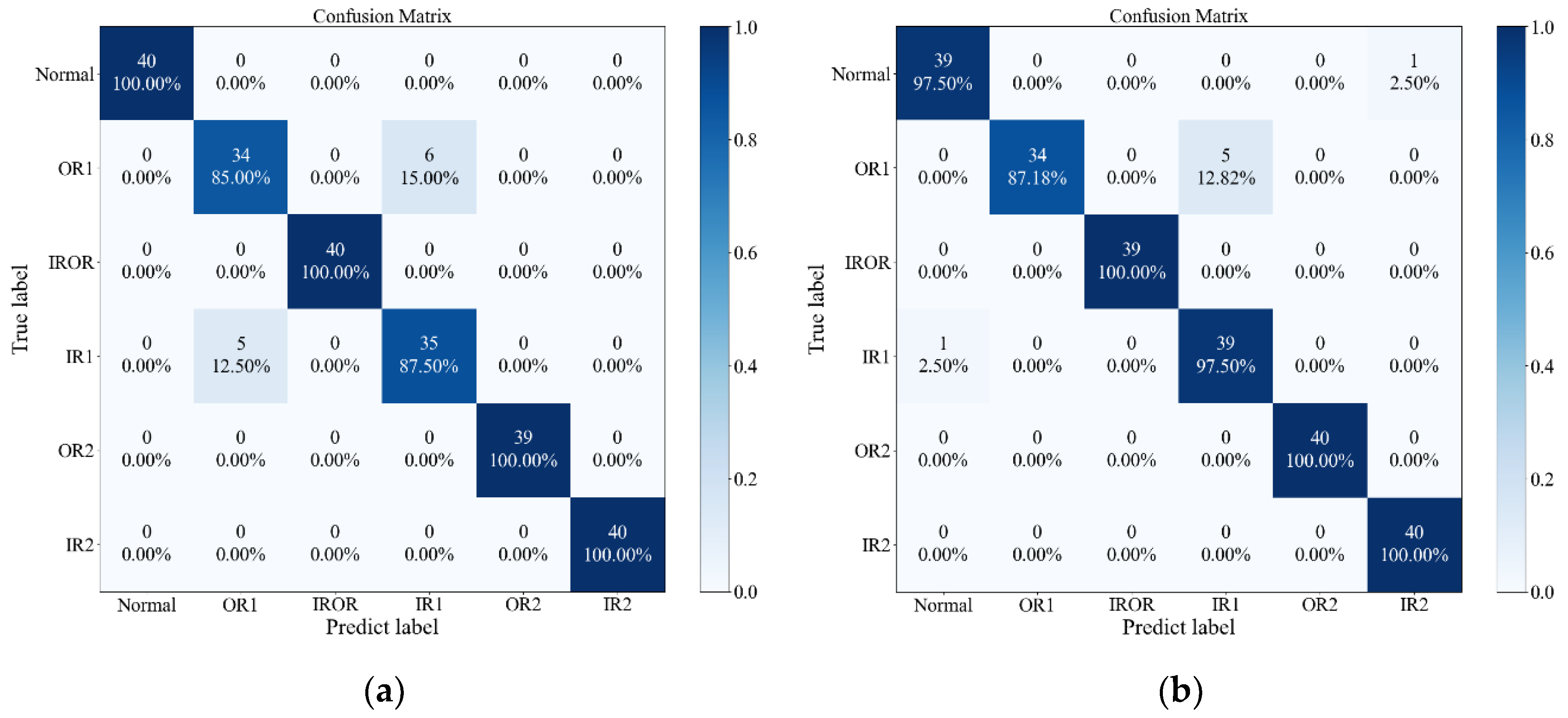
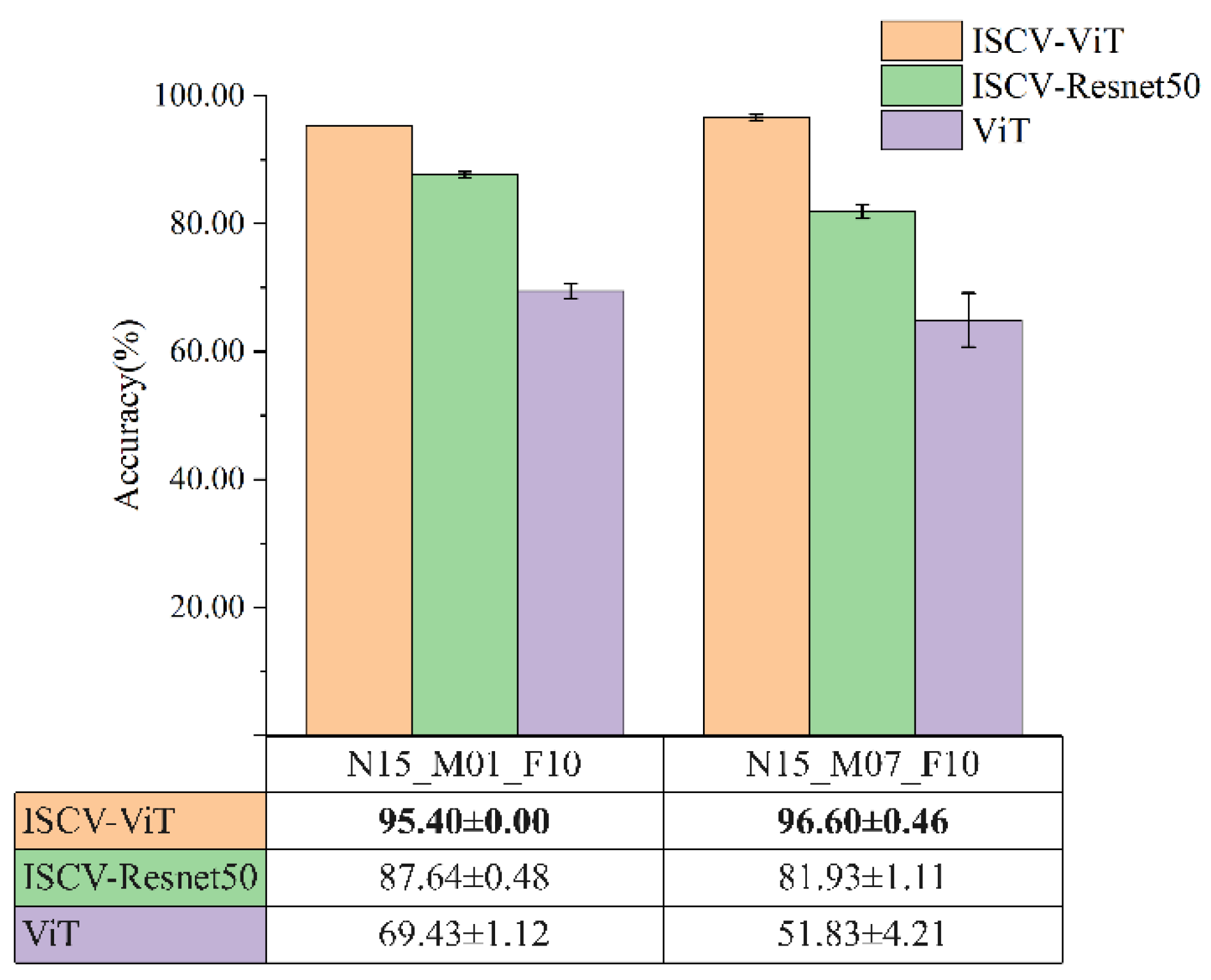
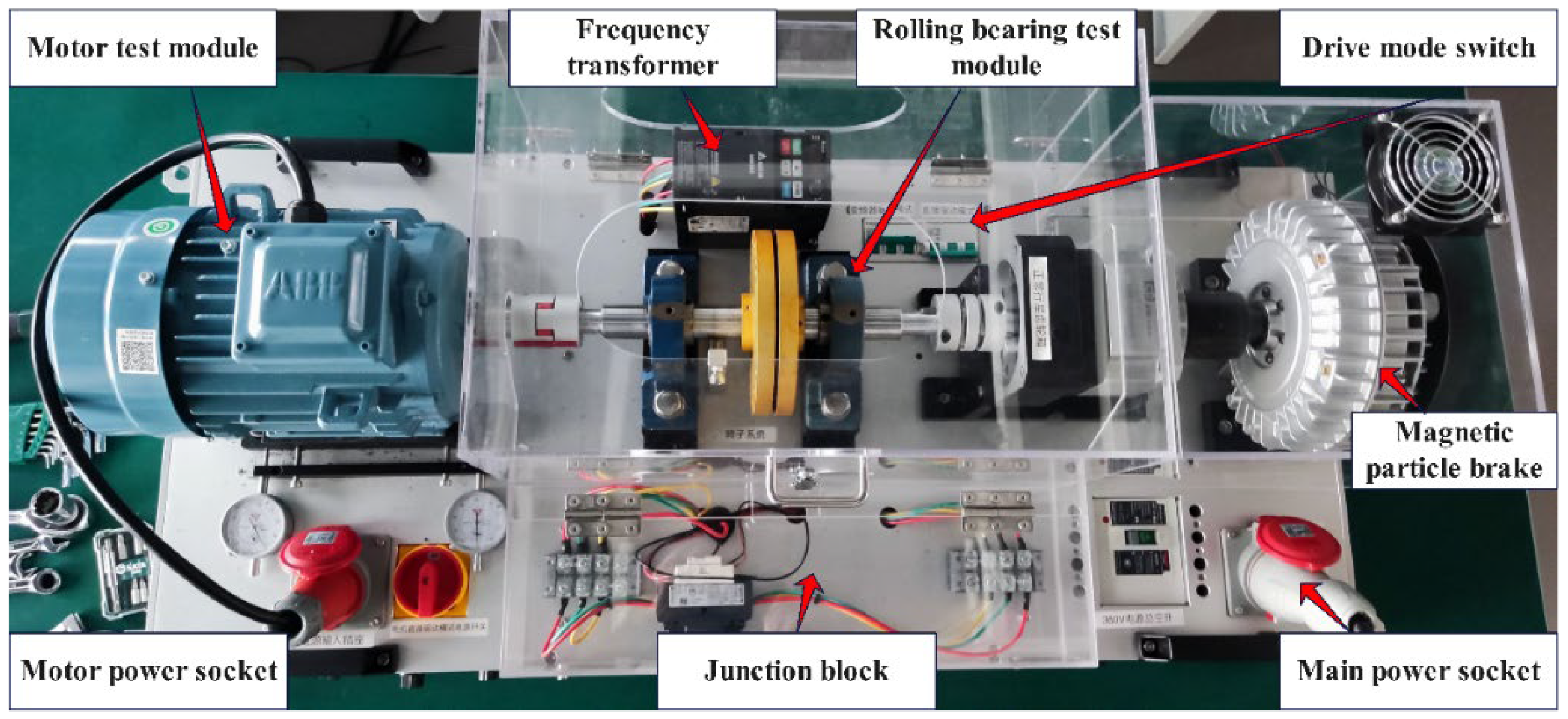
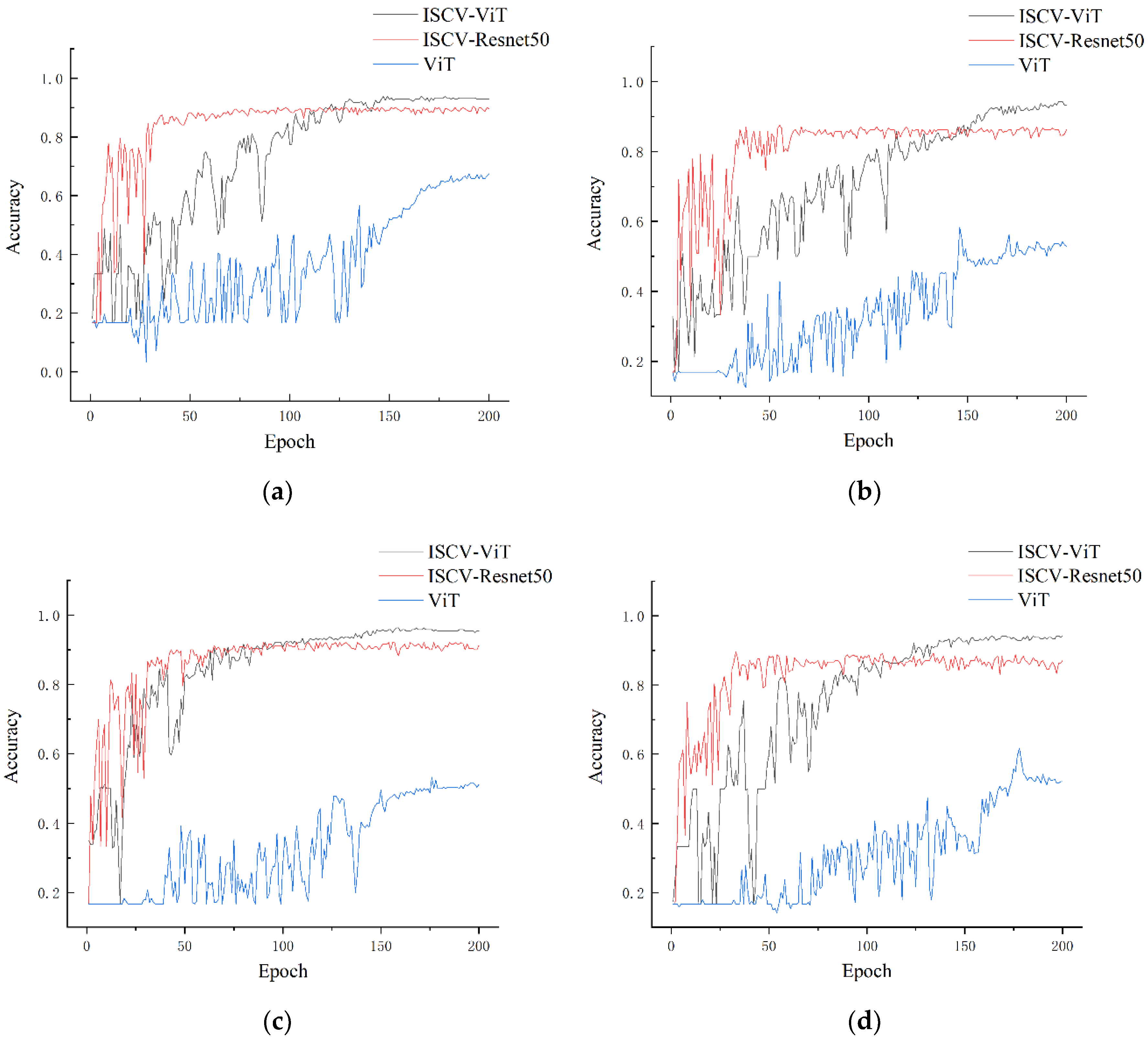

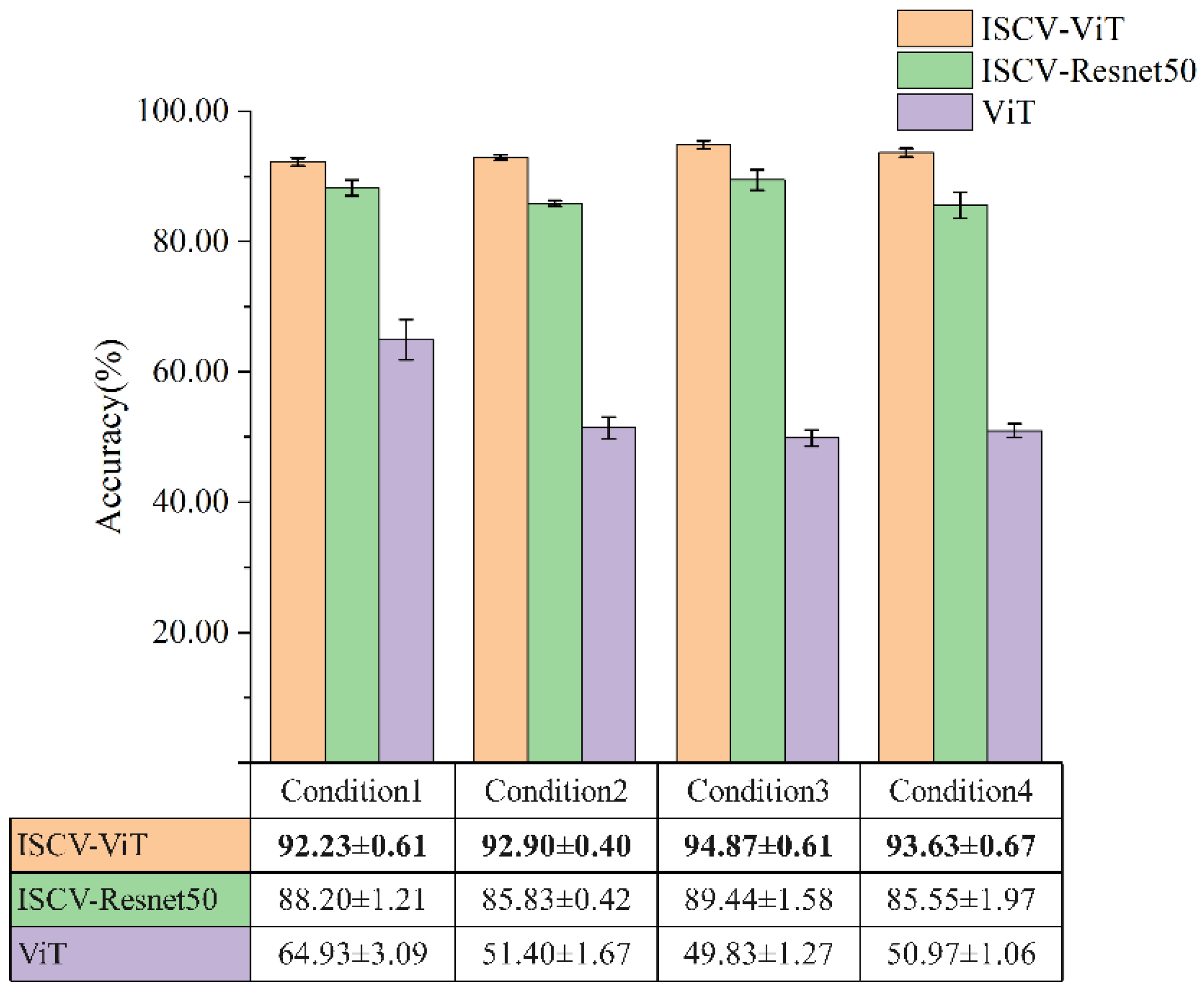
| Value | |
|---|---|
| Input image size | |
| Number of Transformer blocks | 12 |
| Embedding dimension | 64 |
| Number of attention heads | 12 |
| Position encoding | 1D |
| Model | Hyperparameter |
|---|---|
| ISCV-ViT | Max epochs = 200 |
| Batch size = 32 | |
| Optimizer = Adam (lr = 2 × 10−3) | |
| ViT | Max epochs = 200 |
| Batch size = 32 | |
| Optimizer = Adam (lr = 2 × 10−3) | |
| ISCV-ResNet50 | Max epochs = 200 |
| Batch size = 32 | |
| Optimizer = Adam (lr = 2 × 10−3) |
| No. | Speed (rpm) | Load (N·m) | Radial Force (N) | Condition |
|---|---|---|---|---|
| 0 | 1500 | 0.7 | 1000 | N15_M07_F10 |
| 1 | 1500 | 0.1 | 1000 | N15_M01_F10 |
| Label | Name | Fault Category | Extent of Damage | Combination |
|---|---|---|---|---|
| 0 | K001 | Normal | - | - |
| 1 | KA30 | OR1 (outer ring) | 1 | R (repetitive damage) |
| 2 | KB23 | IROR | 2 | M (multiple damage) |
| 3 | KI04 | IR1 (inner ring) | 1 | M |
| 4 | KA04 | OR2 | 1 | S (single damage) |
| 5 | KI16 | IR2 | 3 | S |
| Algorithm | Accuracy (%) |
|---|---|
| RF | 83.3 |
| BT | 81.7 |
| Ensemble | 93.3 |
| ISCV-ViT | 95.4 |
| Method | Class | Type | Accuracy |
|---|---|---|---|
| ViT | 5 | M | 51.8% |
| ISCV-ResNet50 | 5 | M | 81.9% |
| ISCV-ViT | 5 | M | 95.4% |
| [53] | 4 | M | 96.3% |
| [54] | 3 | M | 97% |
| [55] | 3 | M | 97.2% |
| [56] | 5 | M&E | 92.4% |
| Label | Bearing Code | Fault Location | Damage Description |
|---|---|---|---|
| 0 | Normal | None | Healthy |
| 1 | FBB | Rolling element | Artificial damage, 3 mm peeling pit on bearing ball |
| 2 | FBC | Compound fault (IR + OR) | Artificial damage, 2 mm cracks in inner & outer-race |
| 3 | FBI | Inner-race (IR) | Artificial damage, 2 mm crack in inner-race |
| 4 | FBO | Outer-race (OR) | Artificial damage, 2 mm crack in outer-race |
| 5 | TBW | Retainer | Artificial damage, broken bearing retainer |
| Speed (rpm) | Braking Current (A) | Name |
|---|---|---|
| 1200 | 0 | Condition 1 |
| 0.31 | Condition 2 | |
| 0.62 | Condition 3 | |
| 0.94 | Condition 4 |
Disclaimer/Publisher’s Note: The statements, opinions and data contained in all publications are solely those of the individual author(s) and contributor(s) and not of MDPI and/or the editor(s). MDPI and/or the editor(s) disclaim responsibility for any injury to people or property resulting from any ideas, methods, instructions or products referred to in the content. |
© 2023 by the authors. Licensee MDPI, Basel, Switzerland. This article is an open access article distributed under the terms and conditions of the Creative Commons Attribution (CC BY) license (https://creativecommons.org/licenses/by/4.0/).
Share and Cite
Chen, F.; Zhou, X.; Xu, B.; Yang, Z.; Qu, Z. Instantaneous Square Current Signal Analysis for Motors Using Vision Transformer for the Fault Diagnosis of Rolling Bearings. Appl. Sci. 2023, 13, 9349. https://doi.org/10.3390/app13169349
Chen F, Zhou X, Xu B, Yang Z, Qu Z. Instantaneous Square Current Signal Analysis for Motors Using Vision Transformer for the Fault Diagnosis of Rolling Bearings. Applied Sciences. 2023; 13(16):9349. https://doi.org/10.3390/app13169349
Chicago/Turabian StyleChen, Fei, Xin Zhou, Binbin Xu, Zheng Yang, and Zege Qu. 2023. "Instantaneous Square Current Signal Analysis for Motors Using Vision Transformer for the Fault Diagnosis of Rolling Bearings" Applied Sciences 13, no. 16: 9349. https://doi.org/10.3390/app13169349






